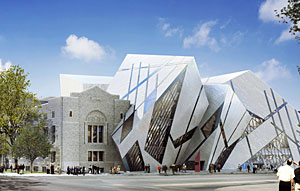Studio Daniel Libeskind is on a roll. Less than a year after its addition to the Denver Art Museum opened to much popular fanfare, if lukewarm critical reviews, another of the firm’s big cultural projects has followed suit: a dramatic expansion of Toronto’s Royal Ontario Museum (ROM), which opened on Saturday. Though separated by 1,500 miles, the two buildings share Libeskind’s signature aesthetic of angular, crystalline forms. They also have in common a key gesture: a prow-shaped volume that reaches over public space. These similarities have led more than a few observers to wonder if the architect’s atelier is copying itself.


Photos: © ROM
In Toronto, Libeskind’s new 175,000-square-foot wing—officially called the Michael Lee-Chin Crystal—faces the city’s premier shopping street and, in a contextual gesture that’s unusual for the architect, forges a connection between this thoroughfare and the original, more austere Beaux-Arts museum. “We were looking to create a lot of transparency and engagement with the city,” explains museum director William Thorsell. “Museums are typically built like fortresses, and we wanted a new, more urban presence.”
But there’s a similar move in Denver, where part of Libeskind’s new Hamilton wing reaches across a plaza to an older section of the Denver Art Museum designed by Gio Ponti. Some Canadian critics say that this coincidence suggests that Libeskind is recycling his forms. The architect himself fueled these suspicions by employing a similar rhetoric of “crystals” when he discusses both buildings—although in Toronto, his ostensible inspiration for the structure’s shape was ROM’s huge collection of geological artifacts.
Although Thorsell dismisses such criticisms out of hand, he admits to following the Denver project closely. “Of course we’ve been there, to see how they’re doing the drywall, among other things,” he says. “It’s true that Libeskind has some language that is typical of Libeskind, just as Gehry or Calatrava or indeed Mies van der Rohe had languages of their own. But the articulation of that language at the ROM is unique. The cladding, the finishes, the nature of the interior spaces are all quite different.”

Post a comment to this article
Report Abusive Comment